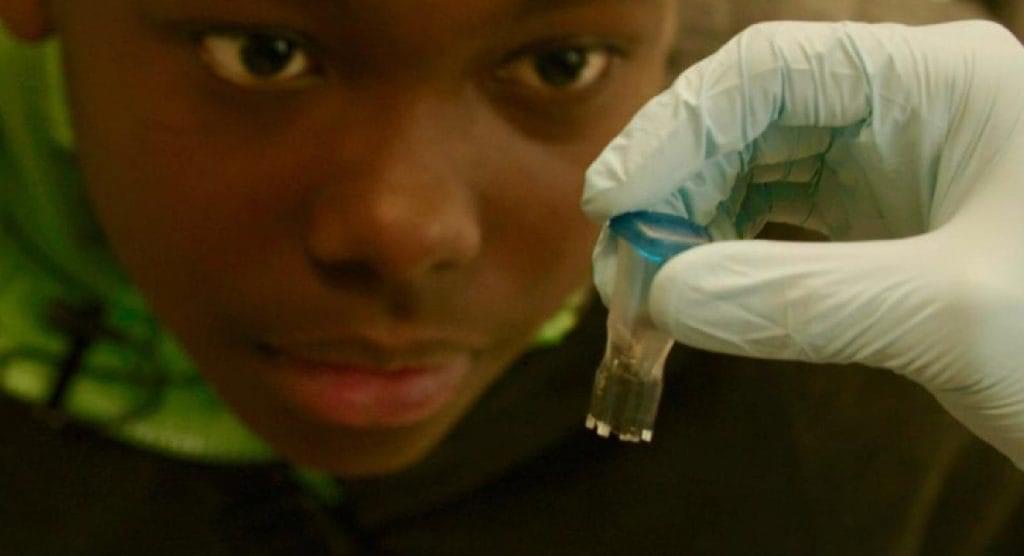
It’s not necessary for you to have seen 1974’s “The Longest Yard” before subjecting yourself to the Adam Sandler version. With most remakes, I’d advise you to avoid revisiting the source material, the better to keep from spitting expletives at the screen, but here it doesn’t really matter. Aside from updating the story to have Paul Crewe (Adam Sandler) driving a Bentley instead of a Maserati in the opening police chase, making Caretaker (Chris Rock) a black guy, and liberally sprinkling the film with jokes about racism and gays, the 2005 remake is by and large the same movie. Entire sequences are lifted line for line and shot for shot from Tracy Keenan Wynn’s original screenplay, meaning – as remakes go – “The Longest Yard” is more akin to Gus Van Zant’s Psycho than the more recent House of Wax.
No Anne Heche, though. Lucky for us.
Director Peter Segal wastes little time getting to the hot prison action. As the movie opens, former NFL MVP Crewe (booted from the league for point shaving) is getting berated by his girlfriend/meal ticket Lena (Courtney Cox-Arquette, proudly showing off her breastfeeding-enhanced décolletage) for being a bum. Crewe sagely asserts his independence by stealing Lena’s luxury automobile and leading the LAPD on a drunken high speed chase. This conveniently violates Crewe’s federal probation, and lands him – inexplicably – in Allenville, a West Texas prison. Guess Crewe should’ve hired O.J.’s lawyers.
Segal gets one thing right: we like prisons and football in the Lone Star State, and Warden Hazen (James Cromwell) has a crack semi-pro team made up of Allenville’s surprisingly beefy guards (played by, among others, Bill Romanowski, Brian Bosworth, and “Stone Cold” Steve Austin). Hazen pulled some strings to get Crewe into Allenville, and wants Crewe to help the team out. Before long, a reluctant Crewe is tasked with putting together a practice squad to play the guards. This proves difficult, as few of the inmates seem too enthused about the prospect. Enter Caretaker (Chris Rock), the savvy inmate who serves as Crewe’s aide-de-camp and liaison with the general population.
Rock introduces the racial joke element largely missing from the original “Longest Yard.” I don’t know about you, but cracks about “getting picked after the white kids” and how fast those black guys can run never get old for me. As in the original, Crewe has to convince the brothers to join the team, and does so by getting pummeled in a game of one-on-one (against Michael Irvin no less). As in 1974, it appears black people only respect strength. That, or the ability to take an elbow to the face.
Sandler’s characters are usually well-meaning goofs prone to strange acts of psychosis. Crewe is an exception, which is easy enough to explain when there are plenty of other head cases to make up for it. For example, there’s the sweet-natured hulk, the cheeseburger-obsessive (if McDonald’s was capable of shame, I’d say they should be embarrassed by this particular product placement), the fat goombah, the silent giant, the psycho, and – if they weren’t enough – wrestling’s own Bill Goldberg.
Every sports misfits movie from the original “Yard” to “Major League” has featured the same inspirational training sequences, and “The Longest Yard” is no different, as Crewe somehow manages to whip his team into shape for their climactic showdown with the guards. “The Longest Yard” also strictly adheres to the sacred and inviolate commandments of the modern football movie:
1) Every play from scrimmage results in either [a] a tackle for a loss, [b] an injury, or [c] a 50-yard gain and/or a score
2) Each hit, no matter how seemingly insignificant, must make a sound like a bank vault door slamming shut. The player on the receiving end must also get knocked backwards as if he was just launched from a trebuchet.
3) AC/DC’s “Thunderstruck” must be played at some point, preferably when the plucky underdogs are making their unlikely comeback.
“The Longest Yard” lives or dies with its physical humor, a form of recent comedy I like to call slapstick sadism. Groins are stomped, noses broken, and brains concussed, but everyone bounces right back up in time to make a wisecrack. There are occasional guffaws, but none of the jokes are more amusing (or farfetched) than the premise that Adam Sandler ever played in the National Football League.
The original “Longest Yard,” while lacking somewhat in diversity, at least bothered to look at issues of pride and self-respect (and even a little Watergate era political subtext). In that version, the guys playing knew they were in prison, and that many were never going to leave. The setting lent the proceedings a little gravity, to the point where the original “Yard” felt like a drama with some football humor thrown in. Here, the cons might as well be at summer camp. They move freely about with little or no visible restriction, and the only sodomy going on is between consenting partners. “The Longest Yard” is little more than the most recent excuse for Sandler and Rock to trot their tired routines out again (and for Burt Reynolds to go buy another facelift) and give American audiences the annual football-related movie we were apparently promised in the Constitution.
Disagree with this review? Think you can write a better one? Go right ahead in Film Threat’s BACK TALK section! Click here>>>

LOL great post
loved your bid about the sacred and inviolate commandments of the modern football movie it is sooo true
its a good movie though
GOOD POINT ABOUT THE RULES FOR FILMING FOOTBALL..THE MOVIE WAS OK THOUGH